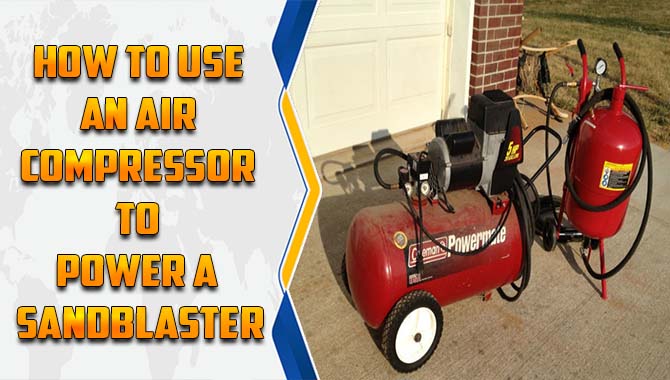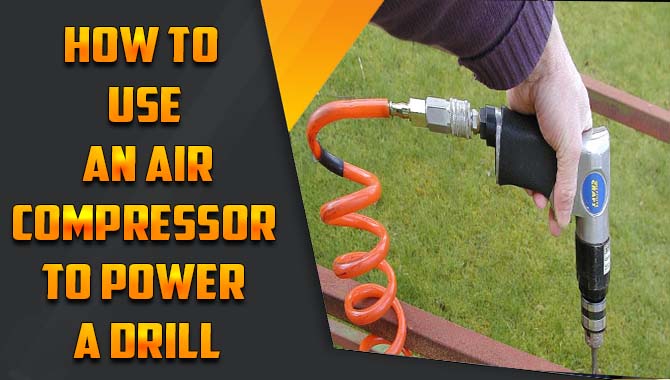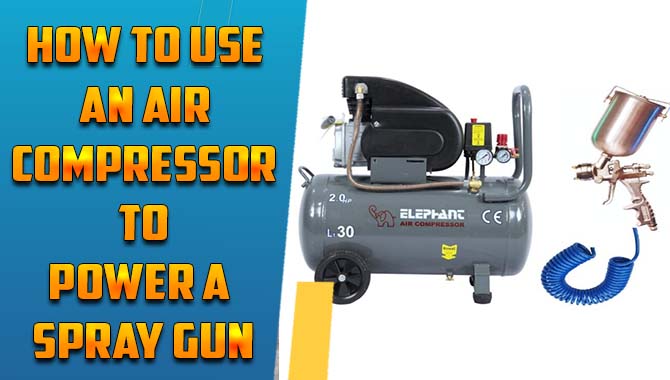Sandblasting with an air compressor can be challenging, especially if you are unfamiliar with the process. Sandblasting is a technique that uses compressed air to propel abrasive materials at high speeds, resulting in smooth and clean surfaces.
Here we will guide you through how to use an air compressor to power a sandblaster. We will cover the basics of sandblasting, including understanding PSI and CFM for sandblasting and choosing the right air compressor for your project.
Air compressors and sandblasters are two tools that are commonly used in various industries. While both of these tools can be used independently, combining them can result in a powerful and efficient method for cleaning and surface preparation. So, read on our provided tips on maintaining your air compressor for optimal performance and cleaning up after a sandblasting project.
What Is Sandblasting?
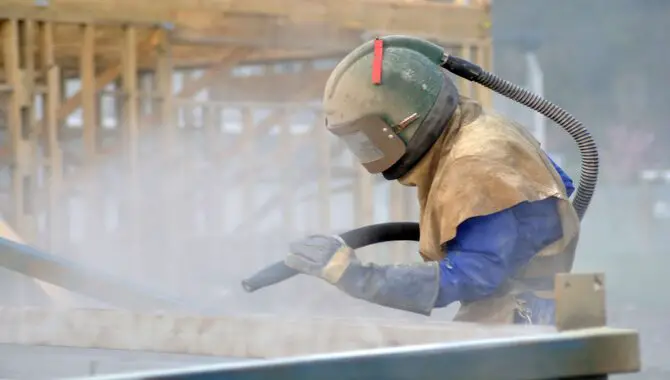
Sandblasting is a technique that uses compressed air to propel abrasive materials, such as sand or crushed glass, against a surface at high speeds. This process helps remove rust, paint, and other coatings from various surfaces, leaving them smooth and clean.
Sandblasting is commonly used in the automotive industry for restoring cars. As well as in construction for preparing surfaces for painting or coating. It requires proper equipment and safety precautions to ensure successful and safe completion of the project.
Understanding PSI And CFM For Sandblasting
To achieve successful sandblasting, it’s crucial to understand the difference between two important terms – PSI and CFM. While PSI represents air pressure delivered by the compressor, CFM indicates the air flowing through the hose. It’s imperative to have an adequately sized compressor with high CFM and enough PSI to achieve optimal results in sandblasting projects.
Determining your sandblaster’s cfm requirement and nozzle size can assist in selecting a suitable compressor size. Other critical factors include abrasive material type and diameter, blast pressure, valve type, intercooler type, durability factor, contaminant level, duty cycle rating, horsepower rating, and cubic foot displacement.
Tips For How To Use An Air Compressor To Power A Sandblaster
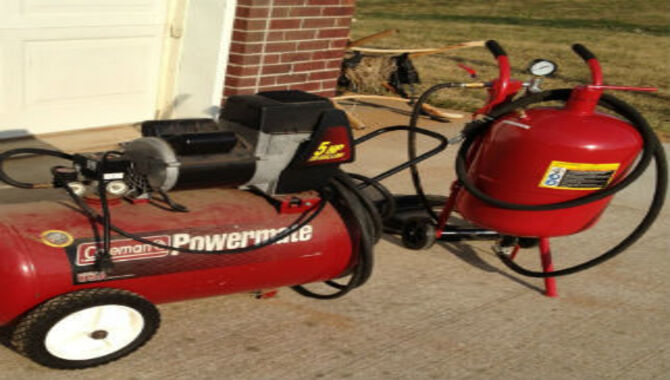
Using an air compressor to power a sandblaster can be a highly effective way to remove rust, paint, and other stubborn materials from surfaces. However, it is important to follow proper safety precautions and techniques to ensure that the process is both efficient and safe.
Here are some tips for using an air compressor to power a sandblaster. By following these tips, you can effectively work on how to use an air compressor to power a sandblaster and achieve great results while staying safe.
- Choose the right size compressor: Make sure that your air compressor has enough CFM (cubic feet per minute) to power your sandblaster.
- Use the right sandblasting media: Different materials require different types of blasting media, so make sure you choose the right one for your specific application.
- Wear protective gear: Always wear protective gear such as gloves, goggles, and a respirator when sandblasting to protect yourself from debris and dust.
- Adjust the pressure: Adjust the pressure according to the material you are working with. Lower pressures are better for softer materials while higher pressures work best for harder surfaces.
Keep the nozzle moving: Keep the nozzle moving constantly to avoid creating divots or uneven surfaces in the area being blasted.
How To Connect The Sandblaster To The Air Compressor
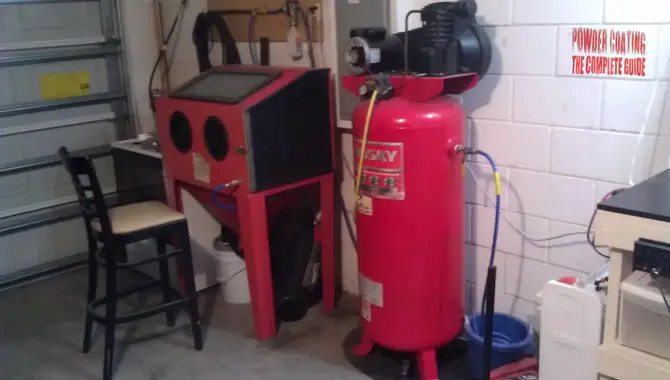
When connecting your sandblaster to an air compressor, it is important to follow these steps: Start by turning off your air compressor and ensure that all connections are secure with no leaks. Next, attach your sandblaster’s hose to the nozzle on your air compressor.
Adjust your pressure settings depending on your specific sandblasting project’s PSI and CFM requirements. Before beginning your sandblasting project, You can test out your sandblaster for any necessary adjustments.
Maintaining Your Air Compressor For Optimal Sandblasting Performance
To ensure optimal sandblasting performance, it’s crucial to maintain your air compressor properly. Checking the oil level regularly and changing it can prevent overheating. Similarly, cleaning or replacing air filters can prevent dust and debris from damaging your compressor.
Inspecting hoses, fittings, and connections for leaks or damage is also important. Finally, match the pressure setting on your air compressor with your sandblaster’s requirements for best results. To keep your air compressor running at its best for sandblasting, there are a few key maintenance tasks to prioritize.
- First, make sure to regularly check and change the air filter to prevent dust and debris from clogging the system.
- Additionally, regularly draining the compressor of any excess moisture can prevent rust and corrosion from damaging the machine over time.
- It’s also important to lubricate the compressor’s moving parts according to the manufacturer’s recommendations to keep everything running smoothly.
- Finally, keep an eye on the compressor’s pressure gauge and make adjustments as needed to ensure consistent and optimal performance during sandblasting.
With these simple maintenance steps, you can extend the life of your air compressor and enjoy reliable sandblasting performance for years to come.
Cleaning Up After A Sandblasting Project
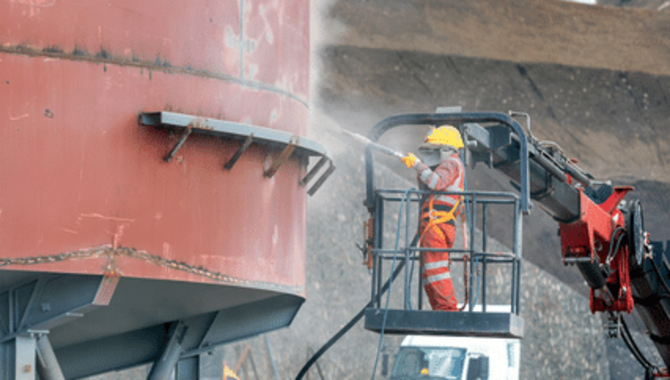
After completing your sandblasting project, it’s important to clean up properly. First, turn off the air compressor and release any remaining pressure. Then, dispose of used blasting media and debris in a safe and appropriate manner.
Use a broom or vacuum to clean up any remaining dust or debris in the workspace. Finally, inspect your equipment for damage and perform necessary maintenance before storing it. With these tips, you can safely and effectively use an air compressor to power a sandblaster for your next project.
Choosing The Right Air Compressor For Sandblasting
When choosing an air compressor for sandblasting, consider its CFM and PSI ratings. A compressor with a high CFM output and sufficient PSI is ideal for sandblasting applications.
A 20-30 gallon compressor with a minimum of 5.0 CFM at 90 PSI is suitable for small-scale projects, while larger projects require a more substantial compressor. Consider investing in a two-stage compressor with an air dryer to ensure a clean, moisture-free air supply for your sandblasting projects.
Types Of Sandblasters
When blasting away contaminants from surfaces such as casing or cylinder, you have two options: pressure feed sandblasters and siphon feed sandblasters. Although both types get the job done, pressure feed sandblasters are better suited for industrial sandblasting because they provide higher psi (pressure per square inch) and cfm (cubic feet per minute) requirement for larger nozzle sizes and abrasive material.
If you want to remove rust or paint from a small area at home, however, your best bet is a siphon feed sandblaster that can handle smaller nozzle sizes and less abrasive material.
Pressure Feed Sandblasters
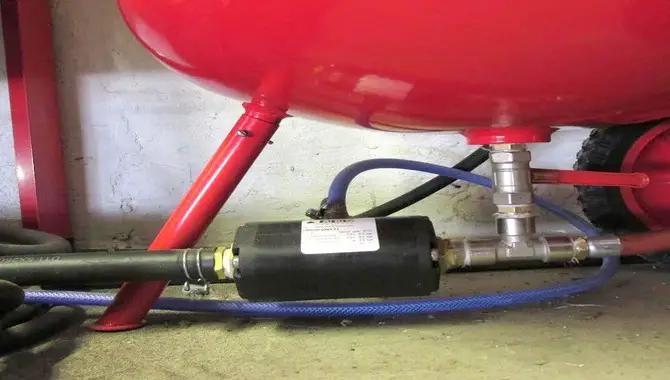
When it comes to sandblasting, pressure feed sandblasters are an important option to consider. Unlike siphon feed sandblasters that rely on a vacuum to pull abrasive material through a tube, pressure feed sandblasters use an air compressor to push abrasive material out of the nozzle. To get optimal performance from these types of air compressors, it’s important to choose the right nozzle size and maintain proper blasting pressure.
Siphon Feed Sandblasters
Siphon feed sandblasters use compressed air to draw abrasive material into a blast nozzle. This type of sandblaster is perfect for smaller sandblasting projects where the volume of air is not a major concern.
When using this type of equipment for sandblasting purposes, it’s important to pay attention to the blasting pressure, which can range from 40 psi to 90 psi, depending on the nozzle size and the abrasive material being used. By selecting the right nozzle size and controlling the abrasive material, it’s easy to achieve high-quality results and remove rust and contaminants from various surfaces.
Using A Piston Air Compressor For Sandblasting
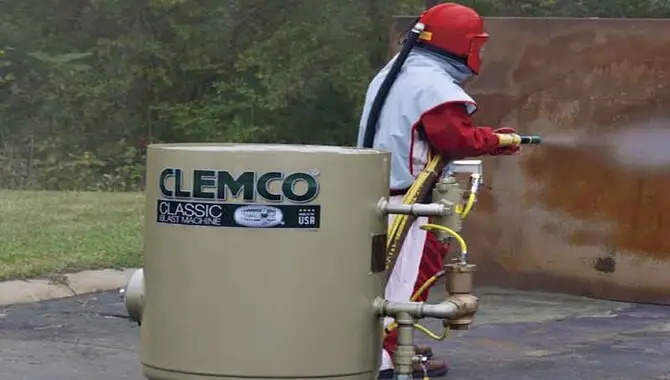
When using a piston air compressor to power a sandblaster, it is crucial to consider various factors affecting its performance. These factors include choosing the right type of air compressor and checking its cubic feet per minute (CFM) requirement to support blasting pressure.
To achieve optimum results, consider factors such as nozzle size, abrasive material, and diameter of orifice. Always use appropriate safety gear while blasting away rust or contaminants from surfaces. Maintaining your air compressor regularly ensures higher durability and efficiency in industrial-type applications.
Horsepower And Tank Size Considerations
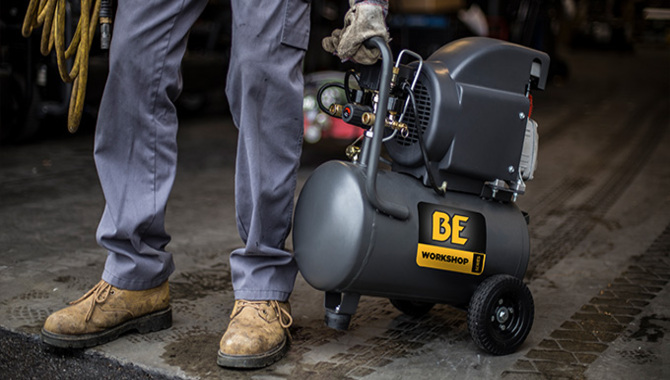
When choosing an air compressor to power a sandblaster, it’s important to consider horsepower and tank size. The horsepower of the compressor determines its ability to deliver air, while the tank size determines how much air can be stored and used at any given time.
For sandblasting purposes, a compressor with at least 5 horsepower and a tank size of 80 gallons or more is recommended for optimal performance. Additionally, proper lubrication and maintenance of the compressor will help extend its lifespan and ensure consistent results for sandblasting projects.
Operating The Compressor For Sandblasting
To operate an air compressor for sandblasting effectively, ensure that you understand your sandblaster’s PSI and CFM requirements and choose an appropriate air compressor based on its specifications.
Connect your sandblaster to the compressor using a pressure regulator and moisture filter for clean and dry compressed air. Remember that choosing the right nozzle size for your project is equally important as it affects the blasting pressure and abrasive consumption rate.
How To Properly Set Up A Sandblaster
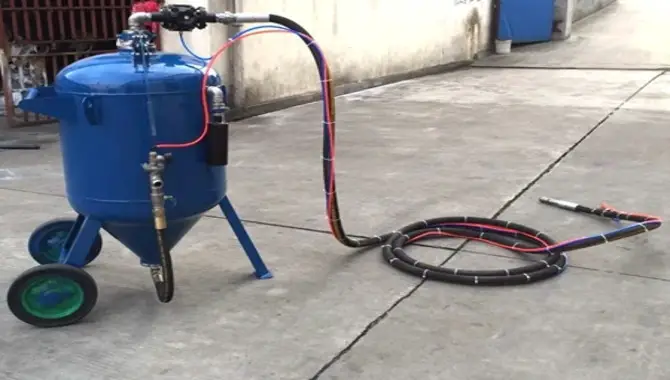
When setting up a sandblaster for a project, choosing the right nozzle size is crucial. The diameter of the orifice impacts blasting pressure and abrasion rate. Also, consider psi (pressure) and cfm (air volume) requirements before choosing an appropriate nozzle size.
Use proper safety gear when sandblasting with different air compressors, such as pistons or rotary screw air compressors. Always check hose connections and adjust air pressure according to your sandblasting needs to avoid contaminants during restoration projects.
Choosing The Right Nozzle Size For Your Project
Choosing the right nozzle size for your sandblasting project involves several crucial considerations. You must decide on the ideal PSI and CFM based on your requirements. Then select a nozzle whose orifice size perfectly matches your compressor’s cubic feet per minute (CFM) output.
Also, remember to factor in the abrasive material you’ll be using and its recommended nozzle size. Ultimately choose a nozzle size that balances air volume with blasting pressure to ensure optimal results.
Importance Of Appropriate Safety Gear For Sandblasting
When it comes to sandblasting, safety gear is of utmost importance. Exposure to dust and abrasive materials can be extremely harmful to your health, causing respiratory problems or even leading to long-term lung damage.
Wear a respirator, goggles, gloves, and protective clothing before embarking on any sandblasting project. Be mindful of the type of sandblasting media you use; some may require additional safety measures. Stay safe by exercising caution and following industry-standard safety guidelines for sandblasting projects.
Additional Resources For Sandblasting With An Air Compressor
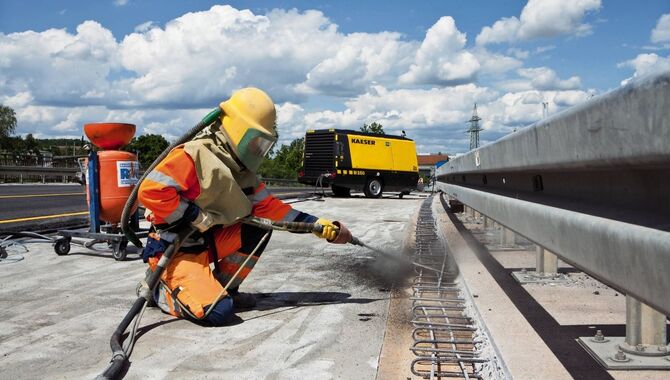
If you’re new to sandblasting with an air compressor, plenty of resources are available to help you get started. Look for online tutorials or instructional videos that provide step-by-step guidance on setting up your equipment and using it safely.
You can consult experienced professionals for advice and recommendations on appropriate techniques and materials. Finally, read the manufacturer’s instructions carefully before using sandblasting equipment to ensure proper handling and maintenance. With a little research and preparation, you’ll be well-equipped to tackle any sandblasting project with confidence and safety.
Conclusion
Sandblasting is a technique that can accomplish some incredible results. However, it requires the right tools and techniques to get the job done correctly. By selecting the right air compressor, connecting it properly to your sandblaster, and using appropriate safety gear, you can achieve fantastic results with ease.
Don’t forget to maintain your air compressor regularly and clean up after each project. Using an air compressor to power a sandblaster can be a highly effective way to remove rust, paint, and other coatings from surfaces.
By following the proper safety precautions and steps, you can achieve professional-level results with this method. Know how to use an air compressor to power a sandblaster, and take precautions accordingly. It is important to wear protective gear such as gloves, goggles, and a respirator to prevent injury or inhalation of harmful particles. Good luck!
Frequently Asked Questions
How Do I Use An Air Compressor To Power A Sandblaster?
When using an air compressor to power a sandblaster, ensure compatibility and connect the air hose between the two. Adjust pressure settings for maximum performance. Always prioritize safety by wearing protective gear and ensuring proper ventilation while using the equipment.
What Are The Benefits Of Using An Air Compressor To Power A Sandblaster?
Air compressors are a reliable power source for sandblasting. And it provides consistent pressure and precise control for various projects. For example: rust removal and surface cleaning.
Is It Safe To Use An Air Compressor As A Power Source For My Sandblaster?
While using an air compressor as a power source for your sandblaster is generally safe, it’s crucial to check that the compressor meets the necessary CFM and PSI requirements. Insufficient air pressure can harm your sandblaster and pose a safety hazard. Always prioritize safety precautions when working with air compressors and sandblasters.
Are There Any Maintenance Tips Or Best Practices For Keeping My Air Compressor And Sandblaster In Good Working Condition?
Yes, regular maintenance is essential to ensure your air compressor and sandblaster are working at optimal performance. Regularly clean and inspect the equipment for any damage or wear and tear. Proper lubrication of moving parts in the air compressor can prevent breakdowns and extend lifespan.
What Are The Different Kinds Of Valves That Can Be Used With Compressed Air Tools Like This One?
When selecting valves for compressed air tools, ball and butterfly valves are the two most commonly used types. Ball valves are hard-wearing with minimal flow restriction, while butterfly valves are budget-friendly. Additionally, needle valves, gate valves, and globe valves can be used. The selection of valve type should depend on the requirements of your compressed air tool.

I am passionate about home engineering. I specialize in designing, installing, and maintaining heating, ventilation, and air conditioning systems. My goal is to help people stay comfortable in their homes all year long.
